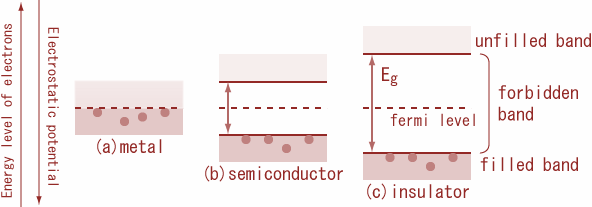Question: Explanations are 100% from NCERT | [Difficult level: Easy] From NCERT NEET Derived Question.
Carbon, silicon and germanium have four valence electrons each.
These are characterised by valence and conduction bands separated
by energy band gap respectively equal to (Eg)C, (Eg)Si and (Eg)Ge. Which
of the following statements is true?
(a) (Eg)Si < (Eg)Ge < (Eg)C
(b) (Eg)C < (Eg)Ge > (Eg)Si
(c) (Eg)C > (Eg)Si > (Eg)Ge
(d) (Eg)C = (Eg)Si = (Eg)Ge
Answer:c
The band theory of solids is used to classify the materials into conductor, insulators and semiconductors. In this question, carbon belongs to insulator, Silicon and germanium belongs to semiconductor.

Conductors: the conductor is those substances which allow the electric current through them easily. It is because there is a large number of free electrons available in a conductor. The conductor's valence band and conduction band overlap with each other so that the energy gap as shown in the figure. Consequently, electrons are free to move, within the substance from the valence band to the conduction band. As a result, a very large number of electrons are available for conduction and such materials are called conductors. Therefore, even a small amount of potential difference is enough to develop an electric current.
Insulator: Insulators are those substances which do not allow the electric current to pass through it. In insulators, the valence band is full, while the conduction band is empty. The energy gap between the valence band and the conduction band is very large. Therefore, a high electric field is required to move an electron from the valence band to the conduction band.
Semiconductors: semiconductors are those substances whose electrical conductivity lies in between insulator and conductor. In a semiconductor, the valence band is almost filled and the conduction band is almost empty. The energy gap between the valence band and conduction is very small. At 0K, the valence band is completely filled and the conduction band is completely empty. Therefore, a semiconductor virtually behaves as an insulator at 0K. At room temperature, some electrons from the valence band cross over to the conduction band., giving rise to little conductivity to the semiconductors. As temperature increases, more valence electrons cross over to the conduction band, and conductivity increases.
We know that,
Energy gap of carbon is 5.4ev, silicon is 1.1ev and germanium is 0.7ev.
From this we can say that,
So, the correct answer is “Option C”.


